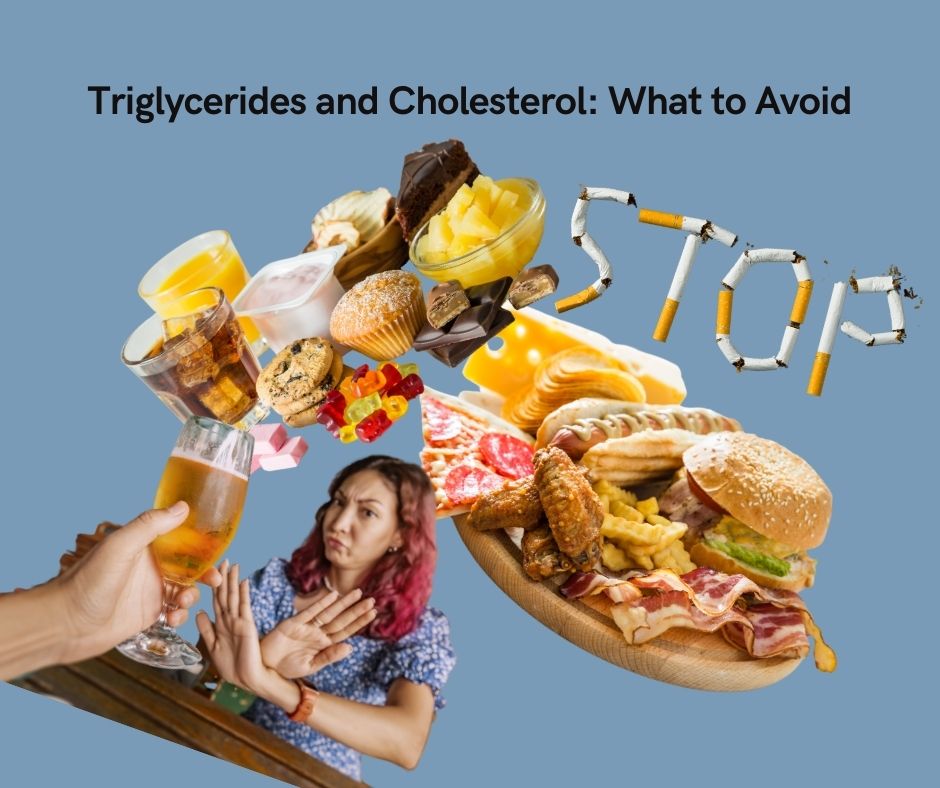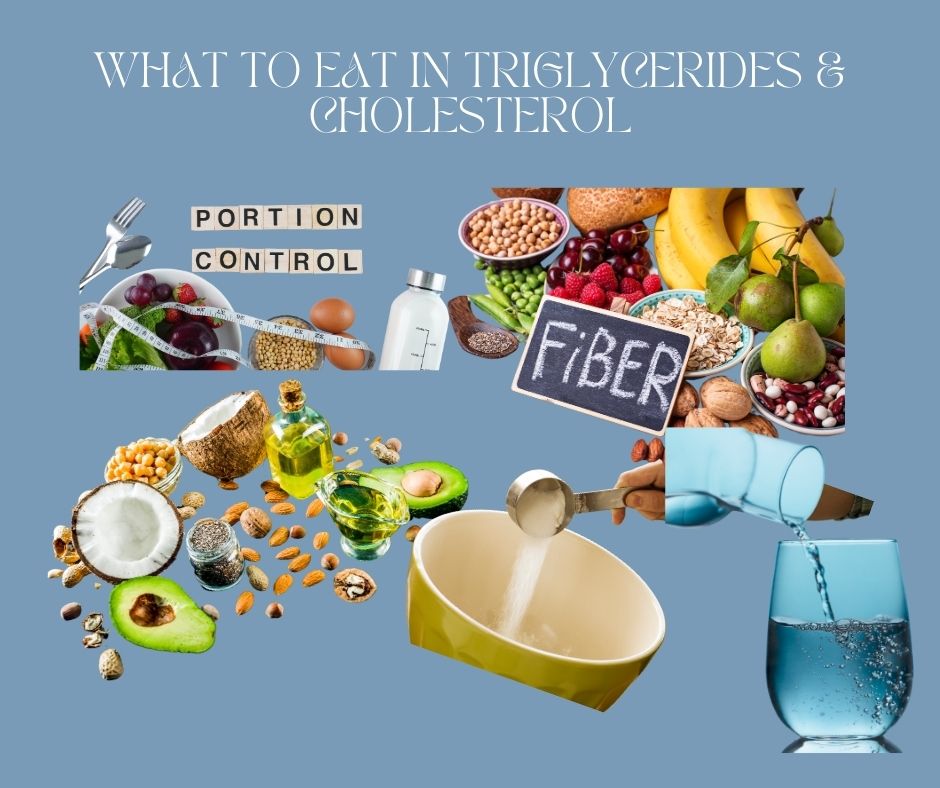
Everything You Need to Know About Triglycerides & Cholesterol
Table of Contents
- 1 Everything You Need to Know About Triglycerides & Cholesterol
- 1.1 WHAT IS CHOLESTEROL AND HOW CAN IT BE CONTROLLED BY A DIET PLAN?
- 1.1.1 Bad Effects of triglycerides and higher cholesterol levels in our body.
- 1.1.2 Things to avoid while having triglycerides and higher cholesterol levels.
- 1.1.3 7 DAYS DIET CHART TO CONTROL TRIGLYCERIDES & CHOLESTEROL LEVEL.
- 1.1.3.1 POINTS TO BE REMEMBERED OTHER THAN DIET CHART TO CONTROL TRIGLYCERIDES & CHOLESTEROL LEVEL.
- 1.1.3.2 EATING HABITS OTHER THAN DIET CHARTS THAT SHOULD BE KEPT IN MIND WHILE WORKING ON REDUCING ELEVATED TRIGLYCERIDES AND CHOLESTEROL LEVEL.
- 1.1.3.3 FAQS Regarding Diet Chart to Control Triglycerides & Cholesterol
- 1.1.3.3.1 1. What foods should I include in my diet to help lower triglycerides and cholesterol levels?
- 1.1.3.3.2 3. Are there specific foods I should avoid to lower triglycerides and cholesterol?
- 1.1.3.3.3 5. Can I still enjoy snacks while following a diet to lower triglycerides and cholesterol?
- 1.1 WHAT IS CHOLESTEROL AND HOW CAN IT BE CONTROLLED BY A DIET PLAN?
WHAT ARE TRIGLYCERIDES AND HOW CAN THEY BE CURED WITH A PROPER DIET REGIMEN?
Triglycerides are a type of fat found in the blood that can have a significant impact on your heart health. High levels of triglycerides are linked to an increased risk of heart disease and other serious health issues. Fortunately, making changes to your diet can help lower your triglyceride levels and improve your overall health. In this blog, we will explore the relationship between diet and triglycerides, and how making simple changes to your eating habits can have a powerful impact on your health. Learn how a personalized diet plan can help you achieve optimal triglyceride levels and improve your overall well-being. We will also discuss a proper 7-day diet chart to control triglycerides & cholesterol in this blog.
WHAT IS CHOLESTEROL AND HOW CAN IT BE CONTROLLED BY A DIET PLAN?
Cholesterol is a waxy substance found in the cells of your body and your blood. While cholesterol is essential to produce hormones, vitamin D, and digestive fluids, high levels of cholesterol can increase your risk of heart disease and stroke. Fortunately, making changes to your diet can help control your cholesterol levels and improve your heart health. In this blog, we will explore the role of cholesterol in the body, and how a personalized diet plan can help you manage your cholesterol levels effectively. By making simple adjustments to your eating habits, such as reducing saturated fats and increasing fibre-rich foods, you can lower your cholesterol levels and reduce your risk of cardiovascular disease.
We will further delve into triglycerides and cholesterol control diet plans in this blog under the supervision of DT. RUKHSANA AZHAR founder of Diet4u Wellness.
Bad Effects of triglycerides and higher cholesterol levels in our body.
1. Increased risk of heart disease: High levels of triglycerides and cholesterol can lead to the buildup of plaque in the arteries, which can restrict blood flow to the heart and increase the risk of heart attacks and strokes.
2. Obesity and metabolic syndrome: Elevated triglycerides and cholesterol levels are often associated with obesity and metabolic syndrome, which can increase the risk of developing type 2 diabetes, high blood pressure, and other health complications.
3. Liver damage: Excess triglycerides can accumulate in the liver, leading to fatty liver disease, inflammation, and potentially more severe liver conditions like cirrhosis.
4. Pancreatitis: Extremely high levels of triglycerides can cause inflammation of the pancreas, a condition known as pancreatitis, which can be life-threatening if not treated promptly.
5. Poor cognitive function: Research has shown that high levels of cholesterol may be linked to cognitive decline and an increased risk of developing conditions like Alzheimer’s disease.
6. Increased risk of gallstones: Elevated cholesterol levels can contribute to the formation of gallstones, which can cause pain and digestive issues.
7. Impaired immune function: High triglycerides and cholesterol levels can negatively impact the immune system, making it harder for the body to fight off infections and illnesses.
Things to avoid while having triglycerides and higher cholesterol levels.
When managing elevated triglycerides and cholesterol levels, it is important to make lifestyle changes and avoid certain habits that can worsen the condition and increase the risk of related health complications. Here are some things to avoid:

1. High-sugar and high-fat foods: Limit consumption of sugary beverages, processed foods, fried foods, and baked goods, as they can contribute to elevated triglyceride levels.
2. Trans fats and saturated fats: Avoid foods high in trans fats and saturated fats, such as red meat, full-fat dairy products, and processed foods, as they can raise LDL cholesterol levels.
3. Excessive alcohol consumption: Alcohol can increase triglyceride levels and contribute to liver damage, so it is important to limit alcohol intake or avoid it altogether.
4. Smoking: Smoking can raise LDL cholesterol levels, decrease HDL cholesterol levels, and increase the risk of heart disease, so quitting smoking is essential for managing cholesterol levels.
5. Sedentary lifestyle: Lack of physical activity can lead to weight gain, higher triglyceride levels, and lower HDL cholesterol levels. Regular exercise is important for maintaining healthy cholesterol levels.
6. Stress: Chronic stress can impact cholesterol levels and overall heart health, so managing stress through relaxation techniques, exercise, and social support is crucial.
7. Skipping medication: If prescribed medication to manage triglycerides and cholesterol, it is important to take them as directed by a healthcare provider and not skip doses.
By avoiding these harmful habits and making positive lifestyle changes, individuals can effectively manage their triglycerides and cholesterol levels to reduce the risk of associated health complications.
7 DAYS DIET CHART TO CONTROL TRIGLYCERIDES & CHOLESTEROL LEVEL.
Diet chart to control triglycerides & cholesterol levels through diet is crucial for maintaining overall health, especially in the context of the Indian lifestyle. Here is a 7-day diet chart tailored by DT. RUKHSANA AZHAR founder of Diet4u to help control elevated triglycerides and cholesterol levels within an Indian dietary framework:
| Days | Breakfast | Mid-morning snack | Lunch | Evening snack | Dinner |
| Monday | Oats porridge cooked in low-fat milk sprinkled with sliced almonds. | A small bowl of mixed fruits like papaya, guava and oranges. | Vegetable Dal khichdi made with brown rice and lentils + cucumber raita. | Handful of salted and roasted peanuts or roasted chana. | Grilled fish curry and 1 whole wheat roti sided with mixed vegetable sabzi. |
| Tuesday | Idli sambhar with coconut chutney. | Fresh coconut water. | Palak paneer made with low-fat paneer + brown rice and salad | Green tea + roasted makhana. | Dal tadka + Methi paratha with a bowl of roasted vegetables. |
| Wednesday | Semolina upma, loaded with veggies and a little spice. | Unsweetened yoghurt topped with flaxseeds. | Chana masala with 2 whole wheat chapati and cucumber salad. | Herbal tea and a handful of nuts like walnuts and almonds. | Vegetable pulao cooked with brown rice with raita. |
| Thursday | Poha, loaded with veggies and peanuts. | An apple or a banana. | Bhindi masala with multigrain roti and a side of sprouts salad. | A cup of lassi made with jaggery. | Grilled chicken curry with sauteed veggies. |
| Friday | A bowl of Dalia, loaded with veggies and a little spice. | Mixed fruits like mango, pineapple and watermelon. | Spinach Dal with jowar ki roti. | A cup of warm turmeric milk. | Egg curry with brown rice and sauteed broccoli. |
| Saturday | Besan Chilla with mint and pudina chutney. | Roasted chickpeas or soynuts. | Rajma chawal, cooked with brown rice and sided with cucumber and tomato salad. | Herbal tea with popcorn. | Bowl of mushroom curry with whole wheat roti sided with mixed roasted vegetables. |
| Sunday | A plate of vegetable uthappam, loaded with veggies and low-fat paneer. | A glass of coconut water. | A bowl of kadhi chawal cooked with brown rice and a side of cucumber tomato salad. | Herbal tea or green tea with a handful of whole-grain crackers. | Grilled chicken curry with whole wheat roti and sauteed veggies. |
In addition to following this balanced diet plan, it is essential to stay hydrated, limit intake of fried and processed foods, incorporate regular physical activity into your routine and consult with a healthcare provider or nutritionist for personalized guidance on managing triglycerides and cholesterol levels effectively within the Indian lifestyle.
POINTS TO BE REMEMBERED OTHER THAN DIET CHART TO CONTROL TRIGLYCERIDES & CHOLESTEROL LEVEL.
In addition to following a healthy diet, there are several key points to remember when aiming to control triglycerides and high cholesterol levels:
1. Regular Physical Activity: Engaging in regular exercise, such as brisk walking, jogging, cycling, or swimming, can help lower triglycerides and raise HDL (good) cholesterol levels. Aim for at least 150 minutes of moderate-intensity aerobic activity per week.
2. Maintain a Healthy Weight: Excess body weight, especially around the abdomen, is often associated with elevated triglycerides and cholesterol levels. Losing weight through a combination of diet and exercise can help improve lipid profiles.
3. Limit Alcohol Intake: Excessive alcohol consumption can raise triglyceride levels and contribute to high cholesterol. It is recommended to limit alcohol intake to moderate levels, which is defined as up to one drink per day for women and up to two drinks per day for men.
4. Quit Smoking: Smoking not only damages the cardiovascular system but also lowers HDL cholesterol levels. Quitting smoking can improve overall heart health and lipid profiles.
5. Manage Stress: Chronic stress can contribute to elevated triglycerides and cholesterol levels. Practice stress-reducing techniques such as yoga, meditation, deep breathing exercises, or engaging in hobbies to promote relaxation.
6. Monitor Blood Sugar Levels: High blood sugar levels can increase triglycerides and lower HDL cholesterol. Individuals with diabetes or prediabetes should closely monitor their blood sugar levels and work with healthcare providers to keep them under control.
7. Get Regular Health Check-ups: Regular visits to healthcare providers for lipid profile tests and overall health assessments are essential for monitoring triglycerides and cholesterol levels. Follow up with healthcare recommendations for managing lipid abnormalities.
By incorporating these lifestyle factors along with a balanced diet, individuals can effectively manage triglycerides and high cholesterol levels for better heart health and overall well-being.
For more information about Diet Chart to Control Triglycerides & Cholesterol contact us.
EATING HABITS OTHER THAN DIET CHARTS THAT SHOULD BE KEPT IN MIND WHILE WORKING ON REDUCING ELEVATED TRIGLYCERIDES AND CHOLESTEROL LEVEL.
In addition to following a specific diet chart, there are several eating habits that can help reduce cholesterol and triglycerides levels:

1. Portion Control: Pay attention to portion sizes and avoid overeating, as consuming large portions can lead to weight gain and elevated lipid levels. Use smaller plates, chew slowly, and listen to your body’s hunger cues to avoid overeating.
2. Choose Healthy Fats: Replace saturated and trans fats with healthier fats like monounsaturated and polyunsaturated fats found in olive oil, avocados, nuts, and seeds. These fats can help lower LDL (bad) cholesterol levels and reduce triglycerides.
3. Increase Fiber Intake: Include plenty of fibre-rich foods in your diet such as fruits, vegetables, whole grains, legumes, and nuts. Soluble fibre can help lower LDL cholesterol and regulate blood sugar levels, which can in turn reduce triglycerides.
4. Eat More Fish: Incorporate fatty fish like salmon, mackerel, sardines, and trout into your diet at least twice a week. These fish are rich in omega-3 fatty acids, which have been shown to lower triglycerides and reduce the risk of heart disease.
5. Limit Added Sugars: High intake of added sugars can contribute to elevated triglyceride levels. Reduce consumption of sugary beverages, sweets, and processed foods high in added sugars to help improve lipid profiles.
6. Stay Hydrated: Drinking an adequate amount of water throughout the day can help support overall health and promote proper digestion and metabolism, which may indirectly impact cholesterol and triglyceride levels.
7. Mindful Eating: Practice mindful eating by paying attention to your food choices, eating slowly, and savouring each bite. This can help prevent mindless snacking and promote better digestion and nutrient absorption.
By incorporating these eating habits along with a balanced diet, individuals can effectively manage cholesterol levels and triglycerides for improved heart health and overall well-being.
FAQS Regarding Diet Chart to Control Triglycerides & Cholesterol
1. What foods should I include in my diet to help lower triglycerides and cholesterol levels?
Include foods rich in omega-3 fatty acids like fatty fish, nuts, and seeds, as well as soluble fibre from fruits, vegetables, and whole grains. Choose lean proteins, healthy fats like olive oil, and limit saturated and trans fats.
2. How can I reduce my intake of saturated and trans fats?
Avoid processed and fried foods, red meat, full-fat dairy products, and baked goods containing hydrogenated oils. opt for lean meats, low-fat dairy, and healthier cooking methods like grilling or baking.
3. Are there specific foods I should avoid to lower triglycerides and cholesterol?
Limit intake of sugary beverages, sweets, refined carbohydrates, and high-fat processed foods. Reduce alcohol consumption and avoid excessive intake of high-cholesterol foods like organ meats.
4. How can I incorporate more fibre into my diet to improve lipid levels?
Include whole grains like oats and barley, legumes, fruits, and vegetables in your meals. Aim for at least 25-30 grams of fibre per day to help lower cholesterol and regulate blood sugar levels.
5. Can I still enjoy snacks while following a diet to lower triglycerides and cholesterol?
Choose healthy snacks like nuts, seeds, fruits, yogurt, or whole-grain crackers to satisfy cravings without compromising your lipid levels. Avoid processed snacks high in sugar and unhealthy fats.
By following a balanced diet rich in whole foods, healthy fats, and fibre while avoiding processed and sugary items, individuals can effectively manage elevated triglycerides and cholesterol levels for better heart health.

Hello My Name is Dt. Ruksana Azhar and I am a certified dietician and providing online & offline services for Weight Management, PCOS/PCOD Management, Diabetes Management , etc. I have 12+ years of experience in the Apollo Hospital Delhi , Max Super Specialty Hospital Delhi, Lilavati Hospital Mumbai and VLCC healthcare Mumbai. I loves to write healthcare and lifestyle related blog. My favorite part of being a doctor is the opportunity to directly improve the health and wellbeing of my patients and to develop professional and personal relationships with them.



